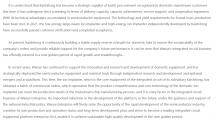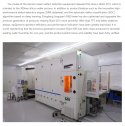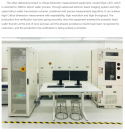Hechen New Materials completed a new round of financing of 100 million yuan, accelerating the domestic substitution of photomask substrates and CMP polishing materials
Hechen New Materials has three categories of products: new display adsorption pads\polishing pads, photomask mask plate substrates, and CMP polishing materials for semiconductors, and has served more than 30 leading domestic customers.
Anhui Hechen New Materials Co., Ltd. (hereinafter referred to as "Hechen New Materials") completed a new round of financing of 100 million yuan, led by Shenzhen High-tech Investment, Anhui Jiangdong Industrial Investment, and Hexian Hesheng Investment , Chengdu Haisheng Junrong, Qingdao Huiwang and other institutions followed the investment, and the old shareholders Dongfang Fuhai and Hexian Fenghe Industry Guidance Fund continued to increase their investment. This round of financing will be mainly used to increase the production capacity of the existing Blank Mask 6-generation line and 8.5-generation Preparation for line expansion, and mass production of CMP polishing materials for semiconductors. Previously, the company had received tens of millions of financing led by Anhui Small and Medium Enterprise Development Fund.
Factory Photo
Hechen New Materials was established in 2016 and is located in Hexian Economic Development Zone, Maanshan City, Anhui Province. It mainly develops and produces new display/optical/semiconductor fine polishing materials and photomask substrates, focusing on domestic new display and semiconductor cards. A domestic alternative to neck material. Hechen New Materials has established a long-term and extensive cooperative relationship with the School of Polymer Science and Engineering of Sichuan University. It is a national high-tech enterprise and a "little giant" enterprise specialized in specialization and new technologies by the Ministry of Industry and Information Technology.For a long time, the main production consumables of the new display industry have relied on imports, and there is no substitute for similar products in China. After chip design companies design chip products, there are still restrictions and material shortage risks in the field of materials, and start-up companies in the field of materials have begun to attract industry attention.In September 2015, the company independently developed and successfully developed a new type of key consumable for display panel processing - adsorption pads. In October of the following year, the production line of adsorption pads was successfully put into production. According to Li Jiahai, this material fills the domestic gap and greatly reduces production costs.

Absorbent pad
This is the first material product of Hechen New Materials. Since then, Hechen New Materials has begun to lay out other materials.So far, Hechen New Materials has three major categories of products: new display adsorption pads\polishing pads, photomask mask substrates, and CMP polishing materials for semiconductors. The company focuses on the domestic production of new display and semiconductor neck materials substitute.
.
CMP polishing pad
According to Li Jiahai, in terms of adsorption pads, the company is at the leading level in the industry, breaking the long-term foreign monopoly; in the photomask substrate business, the company will continue to promote the 8.5th generation line photomask project while simultaneously expanding the production capacity of the 6th generation line It is expected to start trial production by the end of 2023 to achieve localized substitution; for CMP polishing materials, the company has passed multiple rounds of tests by domestic leading end customers, and has also conducted small-batch trial production in many domestic leading wafer companies. Small batch orders have been obtained, and mass production will be achieved in 2023.Li Jiahai told 36 Krypton: "In terms of product performance, Hechen New Materials can achieve the same level as foreign manufacturers or even better, with obvious price advantages, and realize domestic substitution. In addition, compared with foreign counterparts, it shortens the delivery cycle of downstream customers, Saves manufacturing costs."




